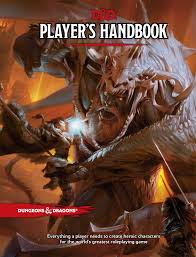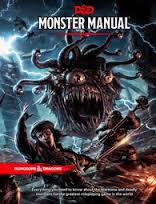The Fifth Iteration: first impressions of 5th ed D&D
 Firstly, if pen and paper RPGs are of no interest to you, then neither will this be. I'm gonna get old school geeky, and I'm not ashamed about it.
Firstly, if pen and paper RPGs are of no interest to you, then neither will this be. I'm gonna get old school geeky, and I'm not ashamed about it.
I don’t do reviews, of course, and these days I don’t honestly get to play tabletop RPGs much of at all, because everyone I know these days is grown up and their lives are made of scheduling clashes, as is mine.
But here is the 5th edition of Dungeons and Dragons and I’m looking at it, thinking ‘This can’t be right. I remember the 2nd ed coming out, surely not that long ago…”
Previously, for my money, I’d have said that the game peaked in the later iterations of 3rd ed (mostly in the form of 3.5 and Pathfinder). It’s probably not a very controversial opinion to say that 4th ed didn’t float my boat, playing out either like a very complicated board game ora sort of offline World of Warcraft clone (with tank specs, for example, and each class having a set of arbitrary abilities and cooldowns for which you could almost hear the buttons clicking) (1).
What does the 5th edition bring to the table, then? Who is it aimed at? Having now had a look at the first 2 rulebooks (Player’s Handbook and Monster Manual), the writers have pulled off a very clever little balancing act. I'd say it’s aimed both at veterans and beginners.
The thing is, how do you improve on (insert your favourite edition here(2))? What’s wrong with 3.5 or Pathfinder, say? Well, nothing, particularly. They are refined and comprehensive iterations of a long-loved game, the product of decades of thought about "how I would improve D&D". The main problem that situation will create, in my very subjective opinion, is one of complexity. There is a continuüm in games design, with realism at one end and stylisation at the other, and most rules can be located somewhere along it. Some games go for a ruleset that doesn’t attempt to model the real world, but is designed specifically to provide very specific game systems — this can have a variety of effects, from freeing up player creativity to constricting it, but either way it doesn't attempt to use its numbers and dice rolls as a way of representing the world "on the ground". 4th ed was like this – it wasn’t very flexible, and it was very game‑y and artificial (again, my opinion) – it came across as an encounter or skirmish simulator. 3rd ed was much more an attempt to model a fantasy world – and more and more so as it (and especially Pathfinder) accumulated additional rulebooks. This gives a high level player unparalleled flexibility – the choice of race, class, skills feats, spells, archetypes, etc. allows you to pull of any character you need. The problem is that, as time goes by, the amount of work this takes, and the amount of knowledge you need in order to do it, grows exponentially. I am one of those gamers who gain a great deal of joy finnicking with numbers and choices to get a character just so, but still, using these sorts of systems to their fullest can be exhausting, and if you do just make a bog-standard fighter, then you’re painfully aware that you’re not using 90% of what’s there.
5th ed is a lot more like 3rd than 4th– and thereby a lot more like 2nd and the sainted original of fond memory. It brings the game back into the sort of RPG territory that 4th ed only fit in uneasily. At the same time, though, it is presented simply and concisely. There is still choice, but things like feats are rationed, and in general creating a character is quick and simple, and still satisfying. Perhaps I might chafe for more options as far as the various class archetypes go – there are only 2 or 3 for most classes – but the ones they include are fun, and there’s very obviously a supplement waiting in the wings that can expand those without overly cluttering the basic systems of the game. And in the midst of all that reductionism, the writers still pull out some unusual choices – a nature paladin, magical fighter and rogue variants, and you can even have a dark pact with Cthulhu if that's your cup of green and steaming tea.
This covers the “newcomer” end of the scale then – the game is eminently pick-up-able and playable. The rules are all slimmed down and easy to grasp – for example instead of everything coming down to strings of modifiers to a die roll, which can be a nightmare to keep track of (3), the game has Advantage (roll twice, take best) and Disadvantage (roll twice, take worst) – and then most of the game simply works on that. Other effects grant bonus dice instead of flat bonuses, which, if no less complex, is generally more fun.
Where is the appeal to the long term player, then? Why do I feel strongly enough about it to be writing this? Aside from the very complete, rounded and user-friendly feel of the PHB, the game also has a strong nostalgia injection. Although it is its own game, it has a strong feel of the original, of recapturing the virtues of the early editions of the game – eg. those versions most of us were playing back in the halcyon days when we got a session every week and the streets were paved with d20s. There is a distinctly retro feel to the whole endeavour, in the best sense of the word, that is perfectly married with the elegant spin they’ve given the mechanics of the game.
The Monster Manual only strengthens this feel – a very carefully forged alloy of old and new. All the creatures there are going to be familiar to the long-term player – and in most cases the art (and the MM art is extremely good – I’m less sold on some of the PHB pieces) is very much in line with older interpretations of the creatures (the carrion crawler is a good case in point). At the same time, someone with an abiding love for the game has sat down and asked ‘why?’ for most of these creatures – most especially ‘why is this world so absurdly full of actively evil monsters’. So it is that most of the denizens of the MM come with at least a partial raison d’etre to explain why they’re troubling the world – and it’s not overdone, and nobody is being a goblin apologist, but it does give a certain depth and dimension to a lot of creatures that were previously little more than numbers on a page and a picture of a guy with the head of a hyena.
 Extra credit: the MM has a whole packed section of mundane and giant animals crammed in at the back, on the basis that you don’t really need to pay for the space that a picture of a goat or a giant spider would take up, just for the stats. Arcane spellcasters are now hard as nails from 1st level, rather than having to be carried by the rest of the party until around 5th. Famously, the section on character gender is explicitly accepting of non-cis possibilities. I have a few reservations – starter characters seem quite fragile compared to some of the damage figures that are flying around; druids have lost their animal companions and sorcerers seem a bit forlorn now that we have warlocks to be touched by dark powers, and now that wizards kick all sorts of ass. Kobolds got nerfed. But seriously, if that’s a reservation, you can hopefully tell how positive I am about the game.
Extra credit: the MM has a whole packed section of mundane and giant animals crammed in at the back, on the basis that you don’t really need to pay for the space that a picture of a goat or a giant spider would take up, just for the stats. Arcane spellcasters are now hard as nails from 1st level, rather than having to be carried by the rest of the party until around 5th. Famously, the section on character gender is explicitly accepting of non-cis possibilities. I have a few reservations – starter characters seem quite fragile compared to some of the damage figures that are flying around; druids have lost their animal companions and sorcerers seem a bit forlorn now that we have warlocks to be touched by dark powers, and now that wizards kick all sorts of ass. Kobolds got nerfed. But seriously, if that’s a reservation, you can hopefully tell how positive I am about the game.
Now I just need to find a chance to play it.
(1) As a surreal touch, the World of Warcraft RPG was still going at that point, and ran as a D&D game using 3rd ed rules. The mind boggles.
(2) Unless your favourite edition is 4th, in which case go stand in a corner.
(3) It was almost a round-by-round chorus in the most recent game I played in: "and another +1 for Bless"
 © 2008-2025 Pan Macmillan
© 2008-2025 Pan Macmillan
I do have to say, they sprung for some nice art this time.
I have a LOT of problems with this iteration (most of which boil down to "you took three years to come up with *this*?"), but damn they put in a ton of effort on the art.